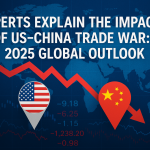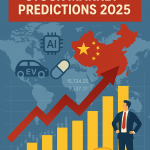🌍 What If China Becomes the World’s Leading AI Hub by 2025?
Imagine this: it’s late 2025, and three of the top five AI companies in the world are Chinese. Their platforms not only dominate Asian markets but are setting global standards in autonomous logistics, voice-based healthcare AI, and quantum-enhanced financial modeling.
Is this far-fetched? Not really.
While many focus on the regulatory challenges in China, few recognize the rapid consolidation, R&D acceleration, and ecosystem expansion of Chinese tech firms over the last five years. In this article, we’ll explore the top Chinese tech companies that are rising in 2025 and analyze what their ascent means for business leaders worldwide.

🔹 Top Chinese Tech Companies to Watch in 2025
1. Huawei Technologies: Beyond 5G and Into the Metaverse
Despite sanctions, Huawei has doubled down on R&D. By 2025, its HarmonyOS is powering IoT ecosystems across Eurasia, and its cloud-based AR/VR infrastructure is laying the foundation for the Asia-led metaverse economy.
2. Tencent: Reinventing Social + Gaming AI
Tencent’s investments in AI-driven game development and digital twins for urban planning have put it at the forefront of immersive tech. In 2025, it’s also quietly becoming the backend cloud for emerging global entertainment platforms.
3. BYD & XPeng: Leading Smart EV and Autonomous Mobility
China’s EV industry is no longer just about cost. XPeng’s smart driving algorithm and BYD’s vertically integrated battery supply chain are setting global benchmarks.
4. Alibaba Cloud: The B2B Tech Empire
No longer just an e-commerce giant, Alibaba is now a critical player in AI-as-a-Service (AIaaS), smart logistics, and green data centers.
5. ByteDance: From Social Media to AI Labs
While TikTok remains a household name, ByteDance’s enterprise AI tools and content personalization engines are being licensed to Western media and retail giants.
6. SenseTime & Megvii: AI for Smart Cities
These two firms have scaled facial recognition, traffic optimization, and security AI platforms to become cornerstones in global smart infrastructure development.
🌐 5 Macro Trends Driving Their Rise
✅ 1. National Tech Self-Sufficiency Agenda
“Made in China 2025” has evolved. There’s heavy state support for chip design, robotics, cloud computing, and biotech startups.
✅ 2. Asian Market Consolidation
China-based platforms are expanding aggressively into Southeast Asia, Central Asia, and Africa. This regional dominance provides scale that fuels further innovation.
✅ 3. Talent Inversion
Brain drain has reversed. Top-tier Chinese STEM graduates are returning home, joining well-funded startups or launching their own with government backing.
✅ 4. Green + Smart Infrastructure
Chinese firms are now global leaders in low-emission manufacturing, battery innovation, and AI-powered grid systems.
✅ 5. Digital Yuan Integration
Digital payments are deeply embedded into business models, creating seamless consumer experiences and enhanced data analytics.
💼 Business Implications for Global Leaders
- Partnership Opportunities: Many Chinese firms are seeking joint ventures and co-development deals, especially in AI healthcare, edge computing, and EV infrastructure.
- Competitor Benchmarking: Understanding Chinese firms’ integration speed, supply chain agility, and platform scalability is essential for any tech strategy.
- Localization Pressure: Firms competing in Asia must now design culturally relevant, hyper-personalized offerings or risk irrelevance.
- Regulatory Strategy: China’s evolving tech policy is both a risk and a roadmap. Western firms can learn from its pace and priorities.
📈 Real Data Snapshot (2025 Q2)
| Company | Revenue Growth YoY | R&D Spend (% of Rev) | Expansion Focus |
|---|---|---|---|
| Huawei | +21% | 18% | EMEA, Asia |
| Tencent | +15% | 22% | South America |
| BYD | +38% | 12% | Europe, SE Asia |
| Alibaba Cloud | +19% | 17% | MEA, India |
| SenseTime | +26% | 30% | Urban AI, LATAM |
❓ FAQ: What People Want to Know
1. What makes 2025 unique for Chinese tech?
It’s the convergence of AI maturity, global expansion, and infrastructure dominance.
2. Are Chinese tech companies safe for international partnerships?
Many are ISO-certified, GDPR-aligned, and offering open APIs for compliance.
3. Which sectors are Chinese tech firms dominating?
AI, EVs, fintech, logistics, e-learning, and smart cities.
4. Should global firms copy China’s vertical integration model?
Not necessarily, but it offers insights on speed, control, and product-market fit.
5. How to track Chinese innovation if you’re outside Asia?
Follow platforms like Pandaily, KrASIA, and TechNode. Subscribe to open R&D datasets and bilingual patent filings.
🚀 Final Takeaway: Ignore China’s Tech Rise at Your Own Risk
The “top Chinese tech companies 2025” story isn’t just about local success—it’s about global realignment. As they scale faster, innovate deeper, and expand wider, no tech roadmap is complete without understanding China’s innovation trajectory.
Stay informed. Stay ready. The 2025 global outlook demands it.

